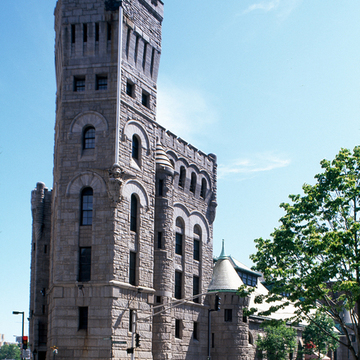Established in 1741 as a militia to protect the governor, the First Corps of Cadets reorganized in 1776 under John Hancock and Henry Jackson and were present at the surrender of Cornwallis at Yorktown. During the Civil War, members guarded Southern prisoners at Fort Warren (WF2) in Boston Harbor. Needing space for training in the 1880s, the corps raised the funds necessary to build a new armory, sited strategically near railroad lines immediately adjacent to Park Street Station and key public buildings (in view of the State House across the Common). The dramatic monochromatic granite structure in the Romanesque Revival style includes a four-story head house and six-story hexagonal tower fronting a massive single-story drill hall. Sold by the corps in 1965, the armory is currently used by a restaurant and for convention exhibition space by the nearby Park Plaza Hotel. The First Corps of Cadets Museum has moved to a town house at 227 Commonwealth Avenue in the Back Bay.
You are here
Armory of the First Corps of Cadets
If SAH Archipedia has been useful to you, please consider supporting it.
SAH Archipedia tells the story of the United States through its buildings, landscapes, and cities. This freely available resource empowers the public with authoritative knowledge that deepens their understanding and appreciation of the built environment. But the Society of Architectural Historians, which created SAH Archipedia with University of Virginia Press, needs your support to maintain the high-caliber research, writing, photography, cartography, editing, design, and programming that make SAH Archipedia a trusted online resource available to all who value the history of place, heritage tourism, and learning.







